Sourdough Einkorn Toasted Oats Bread is a delightfully lean, yet soft bread. The toasted oats give it a slightly nutty taste as does the inclusion of whole grain einkorn.
This oat bread is the bread of the month for the Bread Baking Babes. Elizabeth from blog from OUR kitchen, is the host and she chose this bread as an antidote to all the recent holiday richness.
I love using oats in bread so I always welcome the opportunity. Oatmeal bread (made in a bread machine) is one of the very first breads I ever made, and it’s still a family favorite.
Although I’ve made numerous variations of oatmeal bread over the years, until I made this oat bread, I must say I never thought to toast the oats before adding them to bread dough. Toasting the oats adds a nutty flavor and brings a certain sophistication to the loaf.
Now that I have tried it, I plan to incorporate toasted oats in our family’s favorite oatmeal sandwich bread. It just has to be done.
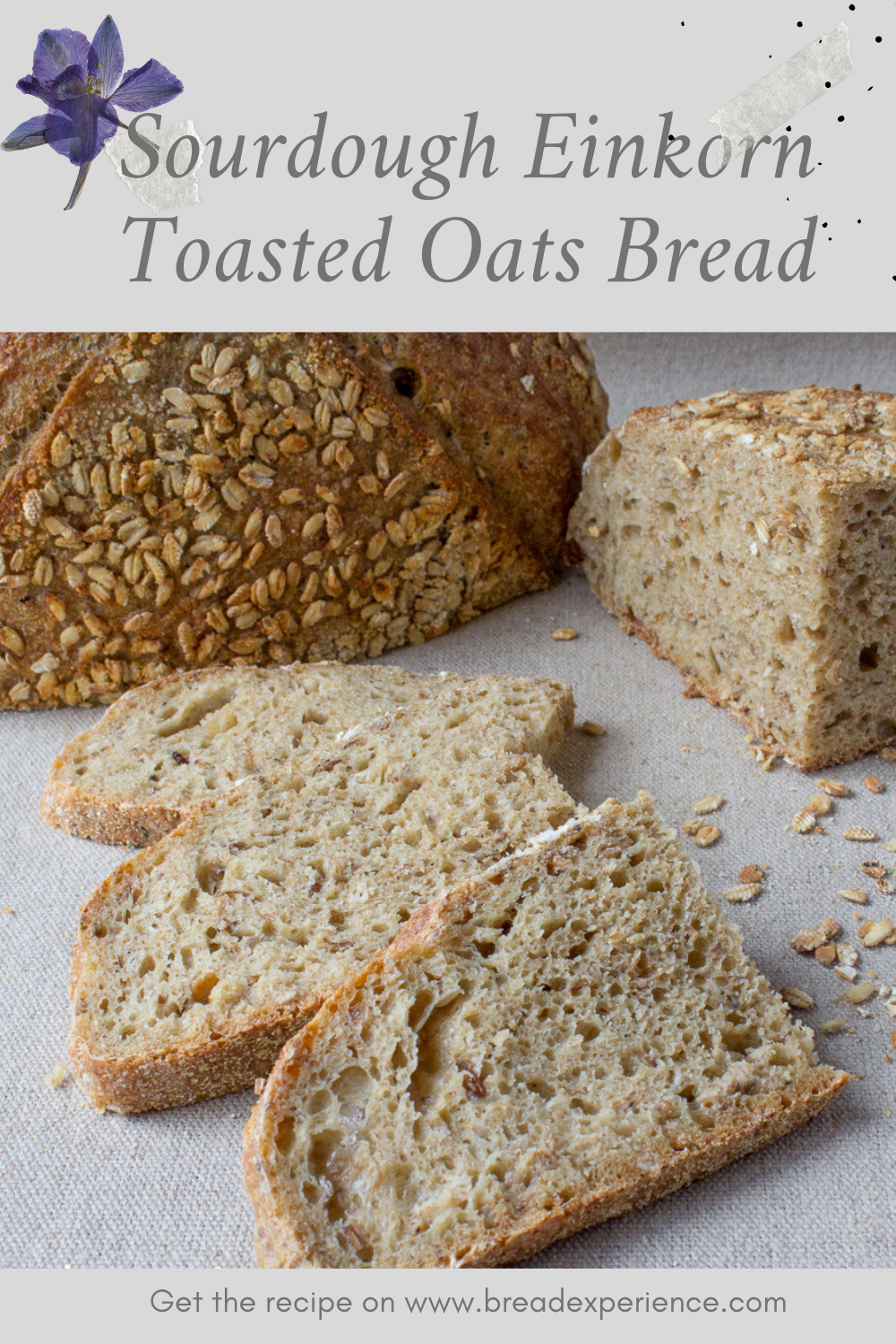
Some thoughts on using oats in bread
There is no appreciable gluten content in oatmeals, so they are used in breadmaking only in very small proportions, to give flavour and add to the fat content (oatmeal is rich in fat).
– Elizabeth David, Bread Flours and Meals, English Bread and Yeast Cookery, p.67-68
Oats are high in protein, fat (compared to other grains), and fiber and have no gluten. We use cooked or prefermented oats in bread, blended with stronger grains […] [F]ermenting these same porridge grains for a day or two before using resulted in loaves with a depth of flavor I had never tasted […] Rather than replacing a percentage of the flour with these grains, [such as oats,] they are added as you would nuts, dried fruit, or seeds, as a flavouring agent rather than a part of the overall flour blend.
– Chad Robertson, Whole Grain Primer | Porridge, Cracked-, and Flaked-Grain breads, Tartine No. 3, p.28, 166-167
Cooked oatmeal makes up the liquid in this recipe, and the result is an outstanding loaf, very different from, and totally superior to, bread made by adding raw oats.
– Laurel Robertson, Oatmeal Bread, Laurel’s Kitchen Bread Book: A Guide to Whole-Grain Breadmaking, p.206
[O]at flour has poor baking properties, so we only add for flavor. We toast them in flake form in the oven before we soak them. Toasting gives a wonderfully earthy and full-bodied character to the bread.
– Casper André Ludd and Martin Ivar Hveem Fjeld, Toasted Oats, Artisan Sourdough, p.144
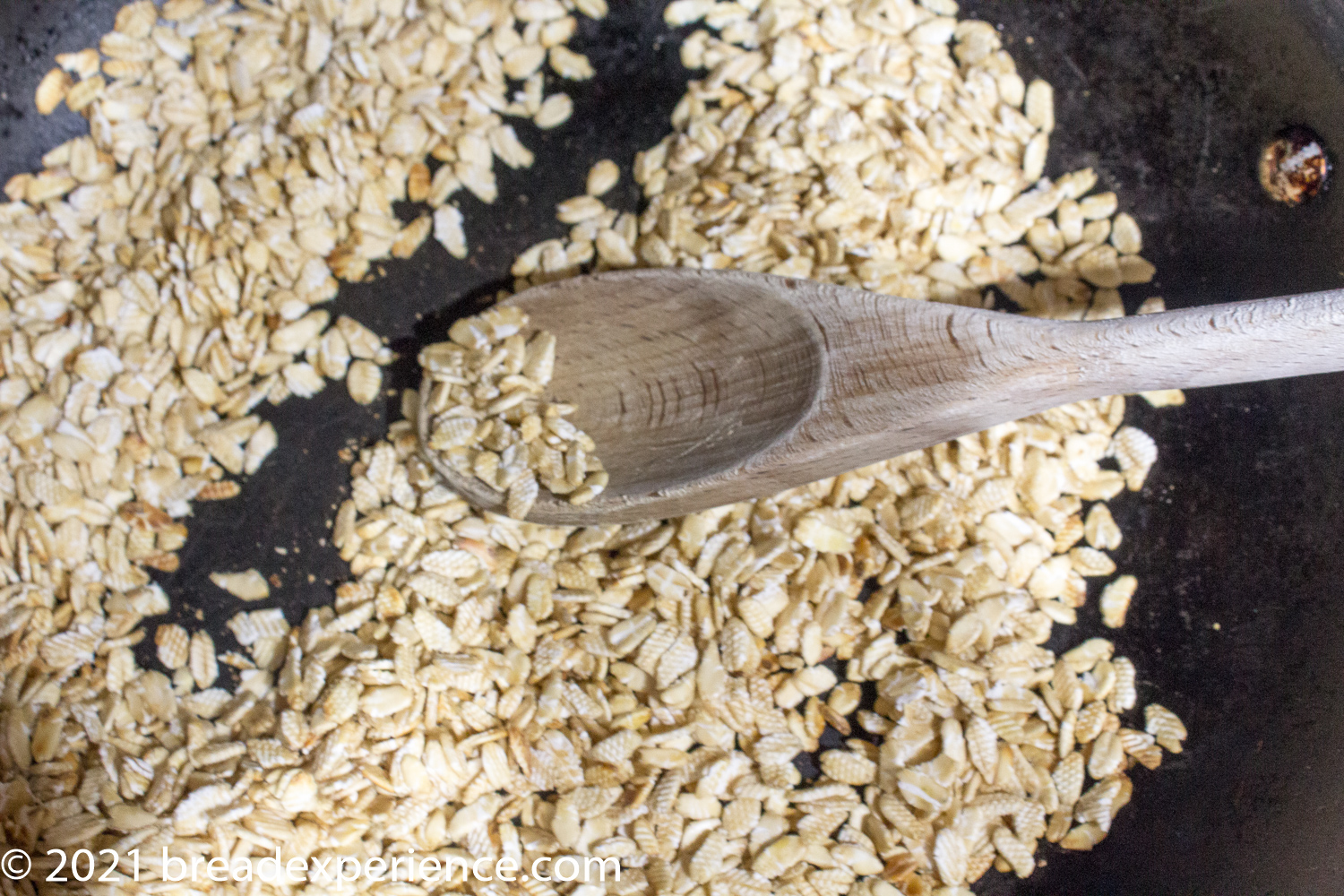
Notes from Elizabeth
Measuring units:
It’s significantly easier to measure ingredients by weight – less clean up and less frantic rummaging through drawers and cupboards in search of cups and spoons. A digital scale is ideal, but a spring scale also works. If you do not have a scale, please look at this excellent online resource from Gourmet Sleuth: Cooking Conversions Calculator
Salt: There’s a very good reason to weigh the salt, rather than use volume measures.
According to Jennifer L Duque (RevelKitchen), one teaspoon of table salt weighs 6 grams, but depending on the brand, one teaspoon of Kosher Salt weighs 3, 3.5 or 4 grams. One teaspoon of salt flakes weighs 2.5 grams.
– Elizabeth, blog from OUR kitchen | Salt is salt, right?
Salt has such a profound impact on heightening the flavor of food and does so in droves before ever tasting too salty. It is the most basic and most humbling seasoning — it enhances rather than adds additional flavors to foods, but its misapplication can easily bite any of us, from the most novice cook to world-renowned Top Chef Masters competitors. Salt can take the form of tiny grains, hefty crumbs, thin crystalline flakes, and many other shapes and densities. […] After using the same salt for a while, we acquire a sense for how salty these rudimentary measures will make food taste and can go along our merry way without fussing with measuring spoons. Switch up the salt, however, and you can get vastly different results.
– Jennifer L Duque, Revel Kitchen | How “salt” can be the kiss of life (or death) in cooking
For more raving about this, please see Salt is salt, right?
Oven Temperature: Our new oven runs a little less hot than our old one (we would have had to bake this bread at 400F in our old oven). I suspect that every home oven is notoriously inaccurate.
Andrew Whitley concurs:
Most domestic ovens, whether gas, electric, fan assisted or solid fuel, will bake bread quite adequately. But, not surprisingly, some are better than others. […] [T]he temperature in the oven may have to fall by as much as 30°C before the thermostat calls for renewed heat, so the item being baked is subjected to a constantly oscillating temperature. […] The knobs and dials on domestic ovens are notoriously unreliable. Even where they indicate a precipe temperature rather than a rough guide or a regulo number, you should regard the setting as approximate. […] [A]ll that is really required is to know what setting gives a cool, moderate or hot oven. […] [I]f you understand roughly what heat a loaf requires (e.g. pretty hot for a big, wet, rye sourdough, moderate for an enriched sweet bread), you won’t go far wrong
– Andrew Whitley, Bread Matters, Chapter three: Taking Control
Cathy’s Notes:
- I used home milled whole wheat einkorn flour and all-purpose einkorn from einkorn.com. I didn’t reduce the amount of water used. I added a little more. If you use a different brand of einkorn, the absorption rate may differ.
- I used oats that I flaked myself but rolled oats will work fine.
- Be sure to toast the oats in the skillet before incorporating in the dough. You’ll be glad you did.
- I followed the instructions regarding adding the oats to the top of the dough before placing in the banneton. This resulted in having too much flour on top and not being able to brush it off because of the oats. When I make this again, I will wait until after I remove the loaf from the banneton and scrap off the excess flour before adding the oats on top.
- I didn’t sift the whole grain einkorn flour, but I had some einkorn bran in the freezer from another sifting so I sprinkled that on the top of the loaf in the banneton.
- I let the shaped loaf proof in the banneton for about 45 minutes, then I placed it in a plastic bag and let it cold ferment in the refrigerator overnight.
- I baked the loaf cold from the fridge after allowing the oven, baking stone, and combo baker to preheat to 475 degrees F. My new oven seems to be 25 degrees less hot whereas my (really) old oven was about 25 degrees more hot. I’m still getting used to that. Refer to Elizabeth’s notes below regarding oven temperatures.
- I placed a baking stone on the bottom rack of the oven and the combo baker on the rack above as indicated in the instructions. This may be the key to getting my new oven to heat evenly. With the baking stone and the baker in the oven, my oven took longer to preheat (which is good.) I usually just have to ignore the beep and let it preheat longer. I will be using this technique again.
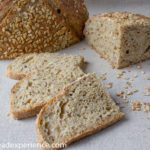
Sourdough Einkorn Toasted Oats Bread
- Yield: 1 Loaf 1x
Description
Sourdough Einkorn Toasted Oats Bread is a delightfully lean, yet soft bread. The toasted oats give it a slightly nutty taste as does the inclusion of whole grain einkorn.
Ingredients
Leavener
- 60 grams whole wheat flour (I used home-milled einkorn flour)
- 60 grams water
- dessert spoon of starter from the fridge (about 30 grams) (I used my 100% hydration einkorn starter)
Oats
- 100 grams rolled oats, toasted (I used home-flaked oats)
- 100 grams boiling water
Actual Dough
- 100 grams 100% whole wheat ‘no additives’ flour (I used home-milled einkorn flour)
- 400 grams unbleached ‘no additives’ all-purpose flour (I used all-purpose einkorn flour)
- 5 grams wheat germ (I omitted this)
- 5 grams malted wheat chops (I omitted this)
- 5 grams ground flaxseed meal
- 325 grams water
- all of the leavener from above, when a small forkful floats in a glass of cool water
- 10 grams salt + 25 grams water + more if needed
- all of the rolled oats mixture from above
- Topping (optional)
- quick (or flaked) oats
Instructions
Leavener:
- In the evening of the day before making the bread: Place the starter, flour and water in a small bowl. Mix with a wooden spoon until the flour is stirred in well.
- Cover the bowl with a plate, or bees wrap, and set aside overnight in the oven with only the light turned on or in a proofing box (unless it is warm enough in your kitchen to proof it on the counter at room temperature)
Prepare the Oats:
- Pour rolled or flaked oats into a dry cast iron frying pan and place it over medium high heat, stirring with a wooden spoon from time to time. It takes about 7 minutes to toast the oats.
- Transfer the toasted oats to a medium-sized bowl and pour boiling water over top. Cover with a plate or plastic wrap (to keep the moisture in), and leave overnight in the oven with the leavener.
Mix the dough In the morning of the day you will be making the bread:
- When a small forkful of the leavener floats in a small bowl of room temperature water, you can go ahead and mix the dough. (my leavener never did float, but I used it anyway after 14 ½ hours.
- In a large mixing bowl, sift the whole wheat einkorn flour, reserving the bran for after shaping. (I didn’t sift the flour) Add the all-purpose flour, (wheat germ, malted wheat chops, if using), and flaxseed meal to the whole wheat flour. (Toasted oats mixture will be incorporated later). Stir with a wooden spoon. Set aside for a moment.
- Weigh the salt and 25 grams water, whisking it together in a small bowl. Set this bowl aside in the oven with only the light turned on or leave on the counter if your kitchen is warm enough.
- Mix the leavener with the 325 grams water to break it up. Pour the leavener/water mixture over the flour mixture. Using a dough whisk or wooden spoon, mix these ingredients together to make a rough dough. Cover the bowl with a plate or bees wrap and leave on the counter for about 30 minutes.
- Adding the salt: Pour the salt mixture over the dough.
Kneading:
- Use one of your hands to squoosh the salt and water into the dough; use the other hand to steady the bowl – this way you always have a clean hand. At first the dough might be a bit messy and seem like it’s coming apart. Persevere. Suddenly, it will seem more like dough than a horrible separated glop. Keep folding it over onto itself until it is relatively smooth. Cover with a plate, or bees wrap, and leave to rest for about 30 minutes.
- Adding the oats and first stretching and folding: Add the oats on top of the dough. Turn the bowl as you fold and re-fold the dough into the center, to distribute the oats. Cover the bowl with a plate and leave on the counter (or if the kitchen is cool like ours in winter and spring, into the oven with only the light turned on).
- Continuing to stretch and fold: Repeat the folding step about 3 times in all at 30-minute intervals. After the final fold, leave the covered bowl in a draft free area until the dough has almost doubled.
Pre-shaping:
- Scatter a dusting of all-purpose flour on your work surface and gently place the dough on the flour.
- Fold the dough over in half, gently patting off any extra flour that might be there. Turn the dough a quarter turn and fold in half again. Continue turning and folding in half until the dough is shaped in a ball.
- Leave it seam side down on the work surface and cover with a large overturned mixing bowl (or a tea towel) and let rest for about 30 minutes.
Prepare the brotform:
- Liberally coat the inside of a banneton proofing basket with rice flour.
- Shaping and adding optional topping: Scatter a very light dusting of flour on top of the round. Gently press down with the palms of your hands to create a disc that is about 4 centimeters deep. Carefully turn the disc over. Without breaking the skin on the bottom, use the dough scraper to fold the dough in half. Turn the dough a quarter turn and continue folding until a ball is created. Leave it seam side down and use the sides of the dough scraper to tighten the dough ball further. Once it has been tightened, wet your hands and rub them gently over the top. Scatter quick oats overtop.
- Now carefully put the shaped loaf seam-side UP into the brotform. Scatter the reserved bran evenly onto the seam area. Cover with the tea towel or an overturned mixing bowl and let sit for an hour or so to allow the loaf to almost double. “Almost” is the key here….
- Alternately, place the loaf in the refrigerator for a cold ferment. This is what I did. I let the loaf proof on the counter at room temperature for about 45 minutes, then placed it in a plastic bag and put it in the refrigerator. The next day, I took the loaf out of the fridge while the oven was preheating, scored it, and then placed it in the hot baker (on cornmeal-dusted parchment paper).
Preheating the oven:
- To know when it’s time to bake, run your index finger under water and gently but firmly press it on the side of the bread. If the dough springs back immediately, recover the bread and leave it on the counter for another 15 minutes of so. If the dough gradually returns back after being pressed, leave the bread on the counter.
- Put a baking stone on a lower shelf of the oven. Place a cast-iron combo cooker (or lidded casserole dish) on the middle shelf and preheat the oven (I set mine to 475F because my oven runs about 25 degrees lower).
Scoring:
- When the oven is thoroughly preheated about 30-45 minutes later, transfer the round into the hot shallow pan of the combo-cooker. (I placed the loaf on cornmeal-dusted parchment paper and used it as a sling to transfer the loaf to the hot baker.)
- Using a lame, sharp knife, or scissors, score the bread in the pattern of your choice. (Ludd and Fjeld score their toasted oats bread in a box-like pattern on top.)
Baking:
- Transfer the loaf (on the parchment paper) to the hot shallow pan of the combo-cooker. Place the pan in the oven and cover with the lid.
- Bake for 25-30 minutes with the lid on. After 30 minutes, remove the lid. Close the oven door and continue baking for another 20-30 minutes, until the crust is a lovely dark golden brown and the bread sounds hollow when knuckle-rapped on the bottom.
Cooling:
- When the bread has finished baking, remove it from the oven and allow it to cool on a footed rack before slicing and eating; the bread is still cooking internally when first removed from the oven! If you wish to serve warm bread (of course you do), reheat it after it has cooled completely.
- To reheat any uncut bread, turn the oven to 400F for 5 minutes or so. Turn the oven OFF. Put the bread into the hot oven for about ten minutes. This will rejuvenate the crust and warm the crumb perfectly.
- Category: Sourdough
Who are the Bread Baking Babes?
We are a group of breadbakers who get together every month and bake bread! We have a Facebook group if you’d like to bake along. New recipes are posted every month on the 16th.
Elizabeth from blog from OUR kitchen is the host kitchen this month. Check out her blog post for more details on how to participate in this month’s challenge.
For more inspiration, check out these posts:
- blog from OUR kitchen– Elizabeth (Host Kitchen)
- Judy’s Gross Eats – Judy
- A Messy Kitchen – Kelly
- Karen’s Kitchen Stories – Karen
- Bread Experience – Cathy
- Feeding my Enthusiasms – Pat
- My Kitchen in Half Cups – Tanna
- Thyme for Cooking – Katie (roundup)
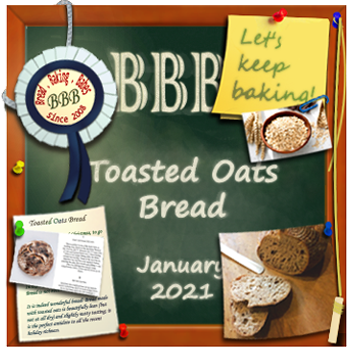
Happy Baking!
Cathy
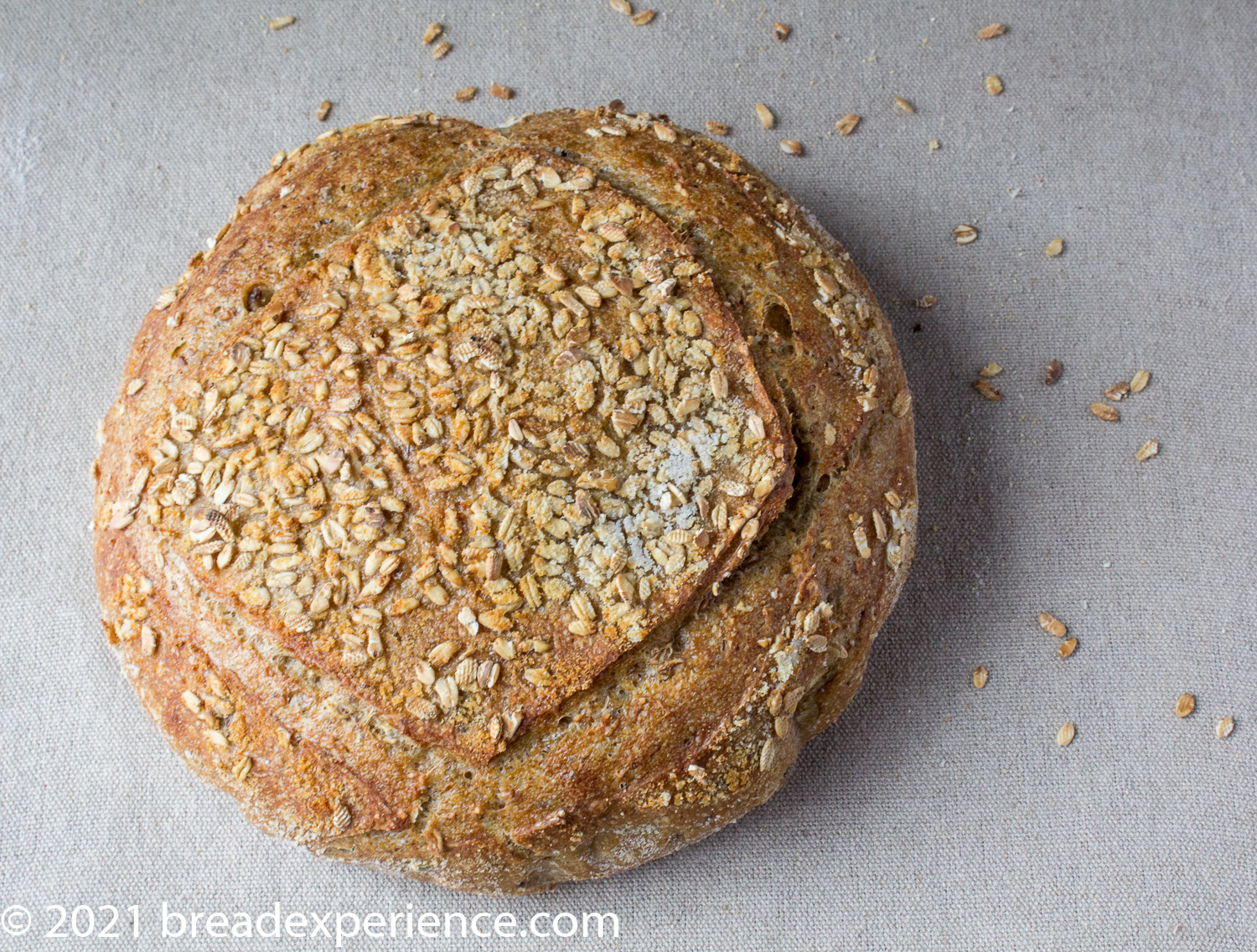
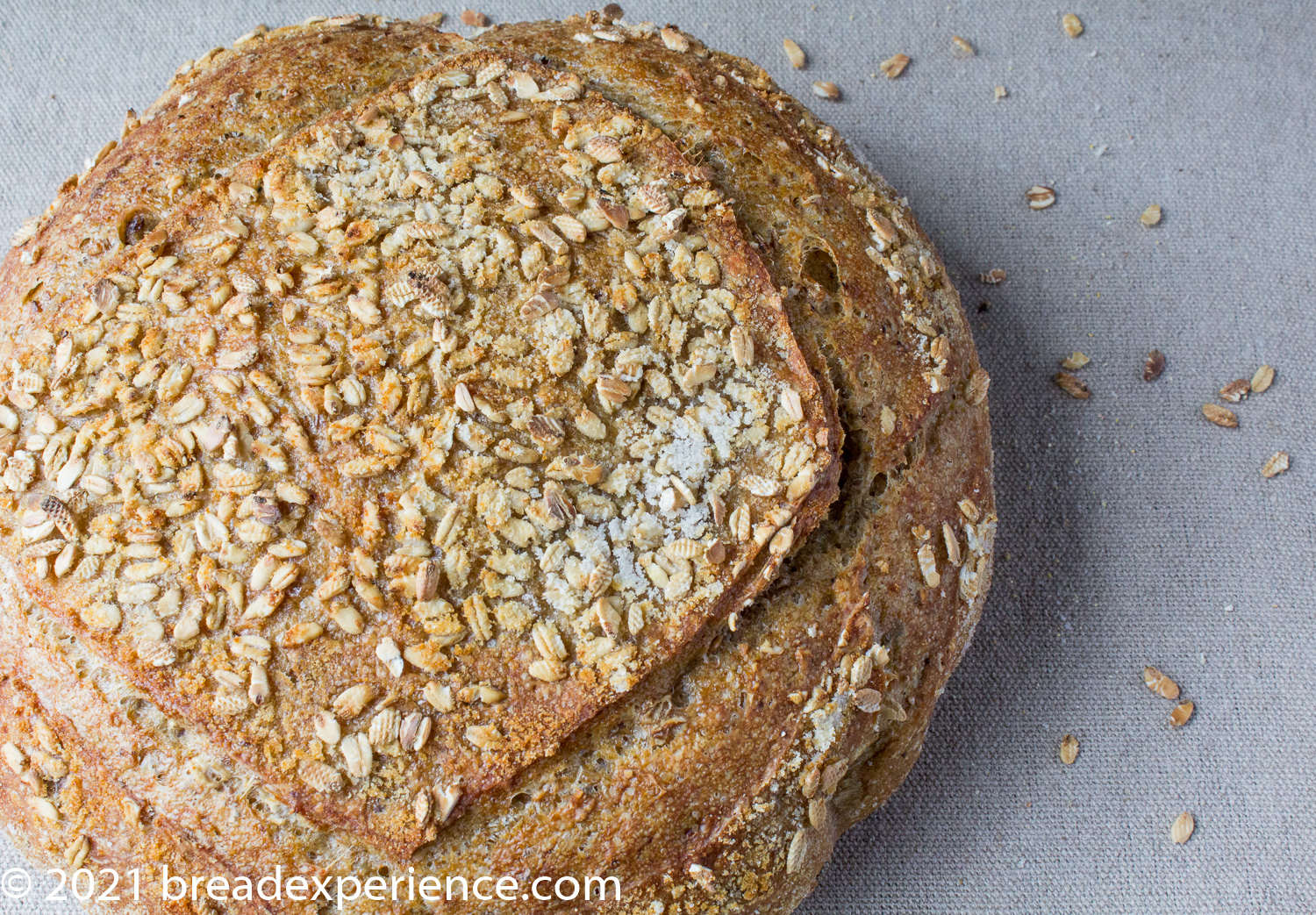
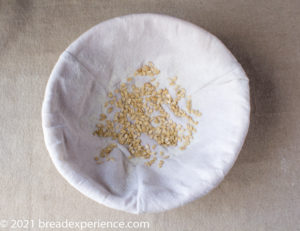
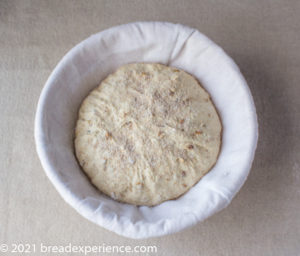
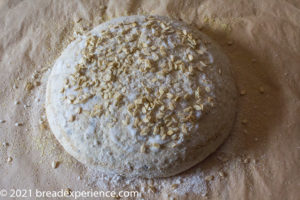
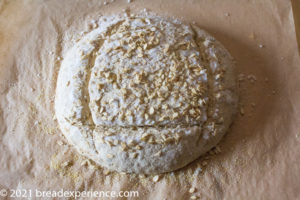
Kelly says
Gorgeous loaf! I love your einkorn results. My new oven is taking getting used to as well. My old ran 25-50º hot and this has tended to run 25º cool but it seems that having 90 extra minutes to sit at 450º made it very fast. My old little oven thermometer died and I really need to get a new one to test across the spectrum!
Cathy says
Thank you Kelly! I was very pleased with the einkorn results myself.
Elle says
Your loaf looks amazing! That golden crust and oat topping is lovely and it surely is light in texture for an oatmeal bread.
Cathy says
Thank you! It is definitely light in texture. Which is one of the reasons I love using oats in bread.
Karen says
Very creative. I’ll have to try the stone plus combo cooker together method!
Cathy says
Thanks Karen! Yes, do try the stone plus combo cooker method.
Elizabeth says
Beautiful loaf!! I really like the scoring pattern too.
We too have noticed that it takes WAY longer for our new (to us) oven to preheat. As you say, this can only be a good thing.
It will be very interesting to learn if using toasted oats in your family favourite bread makes the bread even more favourite.
Cathy says
Thanks for choosing this bread Elizabeth! I do so like the toasted oats. I will definitely try using them in my family’s favorite bread. I think my sons will like it.
Tanna says
Toasting the oat on the stove top was an eye opener to me. Never again in the oven. I particularly liked the way the toasting gave added color contrast in the loaf. I also have a favorite family oat meal bread and yes I am going to be toasting the oats for it. You get such wonderful results from einkorn flour! Yours is indeed a gorgeous loaf.
Cathy says
Thank you Tanna! Toasting the oats (and on the stovetop). An eyeopener indeed!
Katie Zeller says
Such a pretty loaf with all the oats on top….
Cathy says
Thank you Katie!